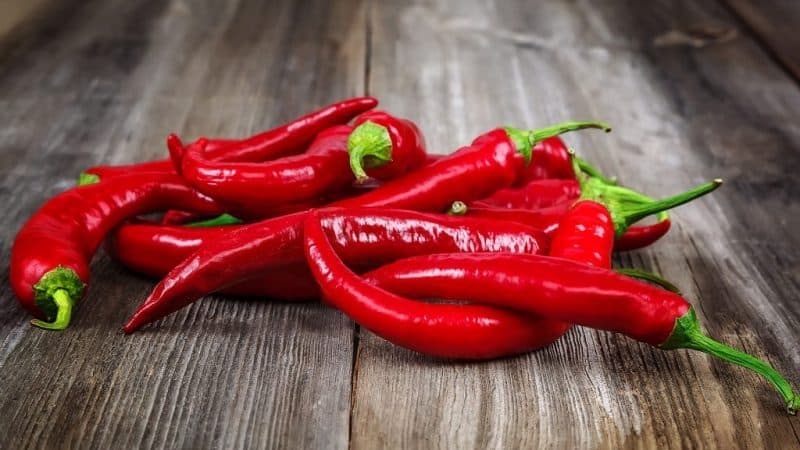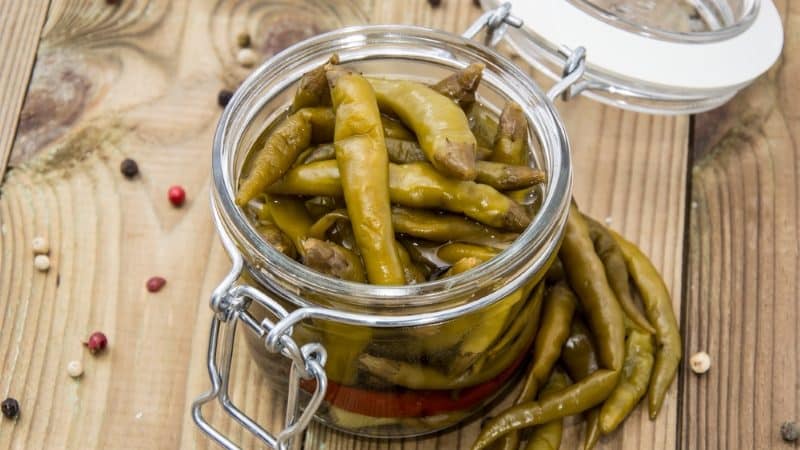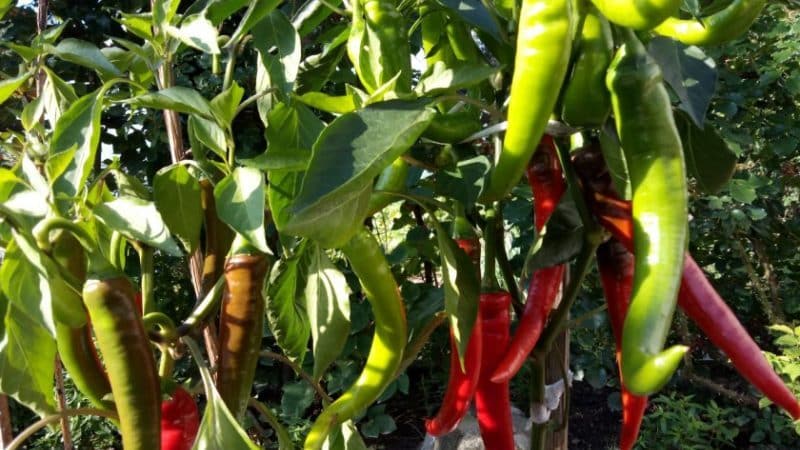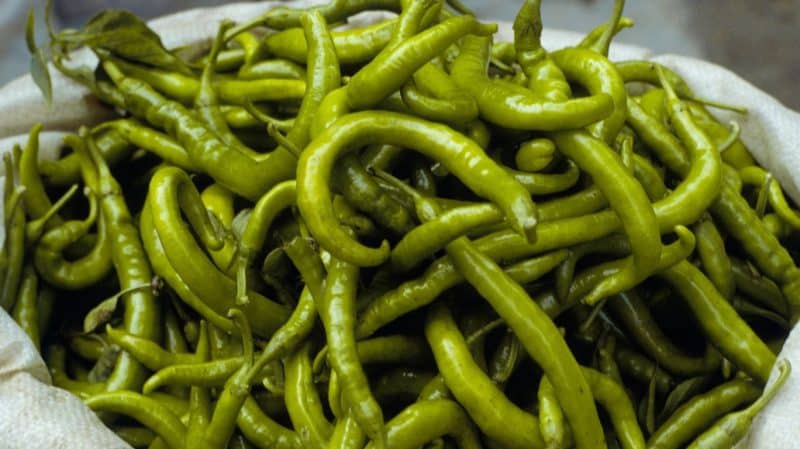Pros and cons of growing Tsitsak pepper: how to get a good harvest
Tsitsak bitter pepper has a pungent taste and excellent keeping quality of the fruit. The name of this unpretentious vegetable translated from Armenian is simply “pepper”. It is very popular in Georgia and Armenia. To get a harvest in regions with a less warm climate, you should know the features of its cultivation and care.
Characteristics and description of the variety
Tsitsak pepper is the result of folk selection. He prefers warm countries. In cool climates it can also produce a good harvest if grown in a greenhouse.
Important! The plant loves sunlight and does not respond well to being in the shade, so the tsitsak should not be covered by other plants during the process of growth and development.
There are not too many leaves on the pepper bushes, the stem is strong. It reaches a height of 70 cm. The leaves of the pepper are green, oblong in shape with a pointed tip.

Advantages and disadvantages
Tsitsak has its advantages:
- high shelf life of fruits - up to 95% of the entire harvest is preserved;
- ease of care;
- resistance to diseases caused by fungi;
- high yield;
- ability to withstand frosts down to -20°C.
Disadvantages of the variety:
- demanding heat, which is why in climates that are not warm enough, tsitsak is grown in greenhouses;
- light-loving - if there is not enough light, this will significantly affect the growth and development of pepper, as well as its yield.
Fruit characteristics and yield
The fruits have an elongated shape, slightly curved at the end. What is the difference between tsitsak pepper and chili pepper? They are similar in appearance, but tsitsak is inferior in the degree of pungency.The cone-shaped fruits are fleshy and covered with smooth skin. Peppers weigh up to 60 g and grow up to 20 cm in length.
Reference. Pepper can be placed next to onions, dill and garlic.
The fruits ripen between 110 and 130 days after planting. Tsitsak is a productive pepper; on average, 2-4 kg of spicy fruits are collected from 1 m². The fruits have different colors depending on the degree of ripeness - from green and yellow to increasingly spicy red.
Tsitsak pepper is a hot, aromatic variety that has a pleasant sweetish note that softens the heat. Therefore, it can be consumed raw.
These peppers are eaten in different ways:
- fresh - in salads and appetizers, meat dishes are especially good with it;
- pickled or salted;
- dried, ground into dust and used as a seasoning.

Growing
Growing tsitsak has its own characteristics. The step-by-step process is as follows.
Seed selection and treatment
In order for the seedlings to emerge smoothly and the seedlings to grow strong and healthy, the pepper seeds should be pre-treated.
Important! To reject empty seeds, existing specimens are placed in water. Those that float to the surface should be discarded, as they will not sprout.
Next, prepare a solution of 2 g of ash and 1 liter of water. It is infused for 24 hours, stirring from time to time. Selected seeds in gauze are placed in the solution for 3 hours. Then the seeds are removed, washed and dried.
There is an alternative method of seed treatment that takes significantly less time. They are placed in a 2% solution of potassium permanganate. It is prepared in the proportion of 10 g of the drug per 1.5 liters of water. The seeds are placed in the prepared solution for 20 minutes. After the procedure, they are removed, washed and dried well.
Preparing the land for seedlings
The easiest way to get optimal soil is to purchase it at the store. However, you can make the mixture yourself. There are several options:
- Mix peat with humus, sand and soil in equal parts.
- Combine turf with soil, humus and sand in equal parts. Add ash to the resulting mixture at the rate of 0.5 kg of ash per 10 kg of mixture. Next, mix the soil with drainage in a 1:2 ratio. Add fresh sod and rotted compost to the mixture.
- Mix humus and peat in equal parts, adding superphosphate and potassium sulfate to the mixture.
Timing and features of sowing seeds
The best time to sow peppers is from February to March. Fill the box with the prepared soil mixture and make 0.5 cm indentations. Soaked seeds are placed in them and covered with soil on top. To make the seeds hatch faster, they are covered with a special agricultural fabric or simple film.
Reference. Pepper requires a certain temperature regime for growth and development. During the day, the temperature range can range from 23 to 25°C, and at night - from 13 to 15°C.
Seedling care
As soon as the planted seeds have sprouted, they should be transplanted. During picking, seedlings are planted in separate containers filled with peat and soil.
Attention! The picking process should be carried out carefully so as not to touch the delicate, still emerging root system of plants.
The soil in which the seedlings are located must be constantly moist. To do this, you should water the planted seeds regularly - every 2-3 days; after emergence - every day. Tsitsak should be watered with water at a temperature of 20-25°C. To avoid fungal infections, you should water the seedlings at the root with biofungicides once every 2 weeks.
Tsitsak is transplanted into open ground 2-2.5 months after sowing the seeds.2 weeks before planting, seedlings begin to be hardened off, reducing watering. The seedlings are taken out into the open air so that they become accustomed to the ambient temperature. Plants are first exposed for 4-6 hours, then the time is gradually increased.
Seedlings need to be planted in a pre-prepared area.. To do this, in the fall, in the beds that are planned to be used for pepper, fertilize the soil with rotted humus and dig it up. Young plants are planted in prepared soil in holes 5 cm deep and wide.
Important! Peppers should be replanted together with a lump of earth, and then sprinkled with soil and watered.
Watering and fertilizing

Plants should be watered regularly, taking into account weather conditions. The soil should be moderately moist. To achieve this result, water 2-3 times a week in the morning or evening.
Tsitsak needs to be fed with nitrogen fertilizers. When 3 leaves appear on the stems, phosphorus and potassium fertilizers are added to the soil.
Reference. Additionally, you can use wood ash fertilizing 1-2 times a week to accelerate plant growth.
Hilling and loosening the soil
Loosening the soil is an important component of success in growing peppers. The soil should be loosened together with hilling. When the seedlings are actively growing, this is done about 5 times. It is important to take into account the period of plant development:
- during flowering, the soil should be loosened to a depth of 12 cm;
- when the seedling has formed ovaries, they loosen it even deeper - 15 cm in depth;
- when fruiting begins, the loosening depth increases by another 10 cm.
If the peppers are planted close to each other, loosening should be avoided during the flowering period.
Rules for forming a bush
For the tsitsak it is important to form the bush correctly.This begins to be done when the plant reaches 15-20 cm in height. During this period, the pepper begins to branch and the first bud appears at the point where the branch forms, which is called the crown bud. Such a bud must be destroyed. This simple procedure will allow the pepper to develop better.
Further formation of the bush involves pinching and removing excess shoots that will not produce ovaries. You should also remove leaves that create unnecessary shade and do not contribute to the nutrition of the fruits that set. Thus, only strong stems with ovaries and fruits will remain on the bush, receiving sufficient light, heat and nutrients.

Prevention of diseases and pests
The Tsitsak variety is resistant to many diseases. However, if not properly cared for, garden pests can ruin the harvest. Among them are the following:
- Aphid - an insect that sucks juices from peppers. As a result of its vital activity, the green mass of the plant turns yellow and dries out. To avoid crop losses, use a solution of wood ash: dilute 30 g of powder in 15 liters of water and add half a glass of liquid soap. The shoots are sprayed with this product.
- Spider mite. This pest lives on the underside of leaves, forming a whitish web. Insecticides will help in the fight against it.
- Slugs. One of the most common garden pests can destroy almost all the fruits of your labor. By eating the leaves, the slug gradually deprives the pepper of normal nutrition. To get rid of it, use the drugs “Karbofos” or “Keltan”.
Reviews from gardeners

Experienced and novice gardeners who have planted tsitsak peppers in their plots note the ease of care and unusual, memorable taste.
Zoya Pavlovna, Taganrog: “Wonderful, moderately hot pepper! I planted the donated seeds quite late - at the very end of March. Of the five seeds planted in cups, four sprouted. Already at the beginning of summer, I transplanted the seedlings into open ground, and at the end of July I harvested the first harvest. Fruits perfectly: I collected as many as 63 peppers from four bushes! We mainly used it for salting and seeds.”
Sergey Borisovich, Moscow: “When I was visiting Tbilisi, I was treated to salty tsitsak. I liked it so much that I decided to grow this pepper myself in my dacha. From the purchased seeds, I first sprouted the seeds into seedlings, and only then planted them under a film on the plot. Although the summer was cool and not very sunny, the harvest was good. The peppers themselves are spicy with a slight sweetish note. The whole family ate them with pleasure, and we even fermented some.”
Ninulia, Pervomaisk: “A friend sent me the seeds along with a photo of her last year’s harvest. The pepper grew quite spreading, up to 60 cm in height. There are a lot of fruits on the bush, the peppers themselves are elongated, at least 20 cm in length. When unripe, they are green and then turn red. The flesh is not very meaty.”
Read also:
The best sweet pepper varieties for greenhouses in the Moscow region.
How to grow and care for decorative capsicum peppers, and can you eat them?
Instructions for growing decorative peppers “Little Miracle”.
Conclusion
Tsitsak is an unpretentious crop. It only requires compliance with the general rules for planting, growing and caring for peppers. The requirement for light and heat is compensated by high yield and long-term preservation of fruits.
What nonsense! The author has never grown this pepper! We have been growing it for many years! The article is crap, as is the website. One trash
Please tell me how to grow this pepper
Who grew tsitsak, please tell me, there is one type of this pepper, which is first green, then yellow and red when ripe. Or there is yellow tsitsak at maturity, which is salted.
Source: https://agronome-en.htgetrid.com/posadka/ogorod/paslenovye/perets/tsitsak.html
Did the author freak out? demands on heat with frost resistance of -20? I didn’t read any further about this insanity